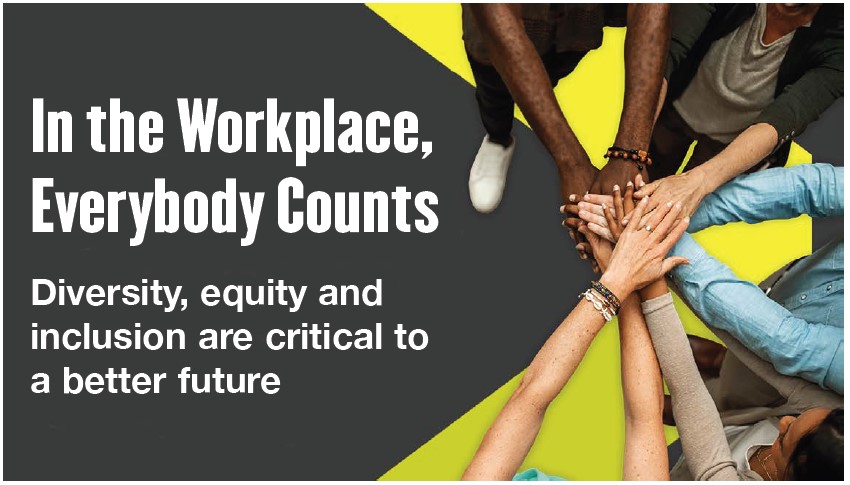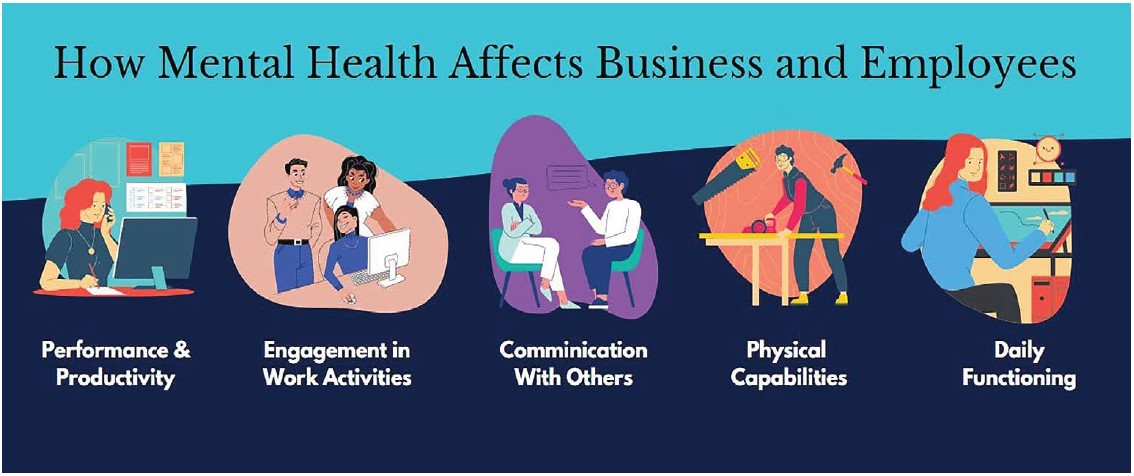In the Workplace, Everybody Counts: Diversity, equity and inclusion are critical to a better future

Chris Christiansen
 Diversity, equity and inclusion (DE&I) awareness is at an all-time high, thanks in part to social justice movements that have emerged over the last few years. While workplaces are heading in the right direction, there’s still a long way to go.
Diversity, equity and inclusion (DE&I) awareness is at an all-time high, thanks in part to social justice movements that have emerged over the last few years. While workplaces are heading in the right direction, there’s still a long way to go.
According to Bank of America Global research, it will take 257 years to close the economic gender gap at today’s pace of change. In 2020, there were no black senior executives in any Financial Times Stock Exchange 100 companies. More than 75 percent of Nasdaq companies don’t have a woman, under-represented minority or LGBTQ+ member on the board.
Below are key points to consider for your DE&I strategy to get us closer to a more equitable, ethical and financially robust future, along with steps that companies can take to drive meaningful change.
DE&I Is an Economic Engine
According to a 2021 study from the Utah Women and Leadership Project, Utah has one of the largest gender wage gaps in the nation, with women earning about 70 percent of — or 30 percent less than — what men earn.
If we embrace DE&I fully, we have an opportunity to build better and fairer. Closing the gender and race gap in education and employment would have generated $2.9 trillion more in economic output in 2019 alone — $70 trillion more since 1990. Our new, post-COVID-19 reality of flexible work-from-home models; online activism among Gen Z; and corporate environmental, social and governance (ESG) commitments are also catalysts that will boost DE&I efforts.
Prioritizing DE&I will deliver greater results for your business, too. Empirical evidence finds that companies with superior scores on workforce and board diversity earn higher return on equity and have a lower earnings risk than lower-ranked peers.
Women Leading the Way
The growing participation and advancement of women in the workforce is boosting productivity, income equality and economic growth. Yet driven by existing inequities, women’s jobs were 19 percent more at risk during the pandemic, compromising progress. If action is taken now to achieve gender-parity improvements, including investments in education, family planning, maternal health, digital and financial inclusion and addressing the burden of unpaid care, $13 trillion could be added to global GDP, according to analysis from McKinsey.
One effort towards that end is Utah’s “returnship” initiative, which provides education, training and temporary paid positions in state government agencies for people who have extended gaps in their resume.
LGBTQ+ Acceptance on the Rise
If the LGBTQ+ population were a nation, it would be the fourth_largest economy in the world. Twenty-eight countries have legalized gay marriage and in 2019, the World Health Organization announced it would no longer consider transgender a “mental disorder.” This isn’t to say things are perfect. Today, only 81 countries offer some form of employment protection for LGBTQ+ workers, and LGBTQ+ employees continue to see critical gaps in workplace benefits and access to healthcare.
Mental Health Can’t Be Ignored
When scored on the state’s overall mental health, Utah ranks 50th among all states, including the District of Columbia, according to Mental Health America. While Utah offers a robust array of public mental health services, many gaps exist, reports the Kem C. Gardner Policy Institute.
Addressing mental health topics openly and honestly, and connecting employees to trusted resources, mentors and support, strengthens a company’s culture and workforce productivity. While nearly half of U.S. adults will experience some form of mental illness during their lifetime, only 60 percent will report it to their company, either out of fear of stigmatization or uncertainty over whether mental illness is a “legitimate” disability claim. We can expect this to change, however, in part because of the importance younger generations place on mental health issues and expanded mental health benefits at workplaces.
Putting DE&I into Action: What You Can Do Now
You can work to create a more inclusive workplace environment by evaluating the needs of your stakeholders and business. Here are key questions and steps to consider:
• Is your workplace designed with DE&I in mind? Consider an external audit of your internal structure and processes, or get advice from an expert in inclusive design principles. Use data to benchmark where you stand and create measurable goals for the future.
• Expand company audits beyond diverse representation to metrics that assess equity and inclusion. For instance, are tenure, promotions and raises equal across represented groups? If not, take swift action to address discrepancies, and implement recurring pay and title audits to continue to ensure equitable compensation practices and hold your company accountable.
• Public comments should reflect internal policies and practices. Before making a statement about supporting social justice, for example, review your company’s policies and make sure you are aligned in your actions.
• Make changes that demonstrate your DE&I commitments. This can include ensuring representation of diverse talent, from the executive level on down; strengthening leadership accountability and capability; enabling equality of opportunity through fairness and transparency; promoting openness and tackling micro-aggressions; and demonstrating unequivocal support for diversity.
• Sometimes employees just need to talk, either in “safe spaces” among themselves or with senior leaders. Try creating internal online and in-person groups for people to share ideas and experiences. Ensure that senior leaders are available and open to honest conversations. Employee engagement builds trust, which in turn drives employee retention, productivity and financial performance.
More than a reactive policy to manage negative behaviors, DE&I must be prioritized as part of a broader corporate strategy. We now know that more diverse and inclusive companies make for better investment results and business outcomes. There is now both a workforce expectation and a business imperative for DE&I efforts that create a better future for all.
Chris Christiansen is the market executive of business banking for Bank of America in Salt Lake City.
Reimagine your workspace: Consider these eight ways to bring welcome change to your office

Aja Macheel
 Do you welcome change in your daily routine or do you avoid it like the plague (or shall I say, like the pandemic)? For some it feels like a welcome and fresh new start but for others the smallest nuance of change is enough cause serious distress and disorganization.
Do you welcome change in your daily routine or do you avoid it like the plague (or shall I say, like the pandemic)? For some it feels like a welcome and fresh new start but for others the smallest nuance of change is enough cause serious distress and disorganization.
As human beings, we thrive on routine and consistency. While we may not notice it, the tiniest shift in our furniture layout, noise level, environment or the addition of other out-of-routine distractions within the workday can add up in a big lack of productivity, leaving us feeling unrested and disorganized.
Whether you worked in a large office during the pandemic, in a restaurant or retail or from your home office, you were likely not exempt from the many changes that the pandemic brought to our workplaces. Not only did a few things change, everything changed. Our furniture layouts look different, restaurants are rearranged, our work and living spaces have combined and we are still seeking social distance, safety and health.
All of this change once seemed temporary but just as we all tried to slide back into our normal work routine, things suddenly shifted again, leaving a lot of uncertainty and deepening our need for versatile and mobile workspaces.
No matter where you’ve landed after these last few pandemic years, it is important to stay focused and create an intentional and healthy workplace wherever you are. Check out the eight ideas listed below to inspire a reimagined workspace. These are easy fixes that do not require construction or remodeling. Each of us can make these adjustments to increase our focus and satisfaction in our space.
1. Clean up the clutter. Find a system to put away your paperwork, files and anything that will linger and leave you feeling incomplete or unfinished at the end of the day or week. When you walk away from your desk for the evening, make sure it is clean and clear, free of any piles or clutter that leaves you feeling distracted. Having a nice clean workspace to start out every day will make you feel clarity for the tasks ahead.
2. Lower the noise levels. There’s a lot going on these days in our home offices or collaborative spaces. Shut your door for privacy, dedicate a pair of earbuds to your workspace and listen to calming, soothing sounds. Add more plants into rooms that echo or feel empty — the foliage of living plants will reduce noise in any room.
3. Divide your space. Are your kids or pets on one side of your workspace while you try to focus on the other side or the room? Consider dividing the room in half with a large plant, a shelf or table. It can feel a little bit risky to cut a room in half with furniture or plants, but it is a great way to create smaller, more focused and intimate spaces at home.
4. Move your furniture around. Moving furniture always gives a space a fresh look and feel. If you find yourself unfocused in the office because you face another person or are too close to a high-traffic area, turn your desk to the wall, face a window or invest in desk dividers for privacy. Once again, adding plants around your desk space in large groups or as a dividing wall will not only reduce noise, but create the privacy barrier you may need.
5. Focus on something beautiful. We have a lot going on in and around our desks that demand our professional attention, but do you have something in your workspace that reminds you to stop, breathe and take a moment for yourself? This is important. Treat yourself to cut flowers to brighten up your day, or to a beautiful bonsai for your desk to give a calm and meditative effect. Let that item represent your calmness and attentiveness to your mental health and remember to regularly treat yourself to something beautiful to grab your attention.
6. Get some fresh air. Make sure you have clean air in your workspace. Not only is this important for mental clarity, its good for your immune system and overall health. Pop your home office window open for fresh air, even on cold days. Consider purchasing an air purifier or fan for under your desk that will gently freshen and move the air to keep you alert. Consider a plant in your space, which can effortlessly clean the air and add to the look of your space at the same time.
7. Eliminate distractions. Constant interruptions are a part of our everyday work life. People pop into your office for quick questions or even a phone ping or email alert can completely derail our focus. Kids and pets also demand distractions too, so no matter where you are, it’s important to draw some boundaries. Consider using a “silence” or “do not disturb” message on your computer or phone during focused work time. Close your office door or put a sign on your desk to "Please do not disturb." The few moments you’ll save by drawing these boundaries will add up in the long run.
8. Consider aromatic additions. Whether its someone’s reheated lunch, stagnant office building air or pet smells from the cat laying next to your keyboard, what our office smells like tends to go unnoticed. Think of tapping into other senses to brighten your space, and don’t leave out the aromatics. Fragrant flowers, fresh balsam cedar during the holidays or a richly scented candle will make the space feel whole and clean to work in.
Step back and look at your workspace in a whole new way and consider the things that are not serving you. Taking the time to practice this self-care will go a long way, no matter how many times you change workspaces. These tips will help your clarity and stamina, no matter what change is around the corner.
Aja Macheel is an interiorscape design specialist with 20 years’ horticultural experience. She is currently the sales manager at Salt Lake City’s Cactus & Tropicals.
MENTAL HEALTH IN THE WORKPLACE: Why a company program that promotes mental health and wellness is essential for success

John Graham
 As we adjust to life in the post-COVID era, focusing on mental health and wellness in the workplace can no longer be just a company perk. It’s become a necessity and mainstay for employees to perform at their best.
As we adjust to life in the post-COVID era, focusing on mental health and wellness in the workplace can no longer be just a company perk. It’s become a necessity and mainstay for employees to perform at their best.
Every individual in a company — from the CEO to the intern — experiences a high level of stress in the workplace with the constant effort to move forward and do better. Even before the pandemic, employees were stressed-out with the ever-present pressure to perform well.
We’ve heard it countless times: When faced with stress, our bodies go into what is referred to as “fight or flight” mode. When this happens, our bodies prepare themselves for danger. Our nervous system releases certain hormones, increasing heart rate, blood pressure and breathing rate. While some stress is good for us, our bodies weren’t designed to handle a large amount of it on a daily basis.
Until recently, mental wellness has been somewhat of a taboo subject — a topic no one wanted to address. But in today’s increasingly stressed-out world, there’s a greater acceptance to embrace it, even in the workplace. For someone to reach their full potential at work, the connection among the body, mind and medicine must be explored, especially if your goal is to recruit, hire and retain high-performing team members.
Here’s why:
• Employees will be more engaged. Employees can better focus when their mental health is in check. Instead of ruminating over their problems, they can pay better attention to their work.
• Productivity and job performance soar. To perform well at work, physical and mental health is paramount. When employees don't feel well from either a physical or psychological standpoint, they may not be able to channel the necessary creativity to do their jobs to the best of their abilities.
• Communication improves. When an employee is in a good place mentally, their interpersonal skills improve. If they do not have a positive mental mindset, they may come across as passive-aggressive, short with others or have a negative attitude.
• Increased energy. If an employee’s mental health issues are being appropriately addressed, they will likely have more energy to go about their daily routines. Depression and anxiety deplete the body of what it needs to function properly on all levels.
• Better decision-making. Mental health plays a vital role in decision-making. If an employee feels well mentally, they are less likely to make poor decisions that impact their overall performance.
There are several steps leaders can take to infuse mental health and well-being into the workplace. First and foremost, leaders need to possess a non-anxious presence and provide an example for those who follow them. Just as with everything else, the leader sets the tone for mental health and wellness.
When mental health is a priority, everyone across the company benefits. It’s time for leaders to destigmatize it and provide the necessary resources to fully realize people’s creativity, energy and resilience.
John Graham is the president and CEO of the Institute for Spirituality and Health at the Texas Medical Center.
THE WORKPLACE ROMANCE: If it's allowed, here are some rules
 Carmen Harra
Carmen Harra
 It’s that time of year when the holidays role around that many people who are single really crave the companionship of another person. One of the most common places people find love is in the workplace. But is that a good idea?
It’s that time of year when the holidays role around that many people who are single really crave the companionship of another person. One of the most common places people find love is in the workplace. But is that a good idea?
When it comes to office romances, it can work, if company rules allow. But keep these five things in mind:
Separate business and pleasure. Once you enter the doors of your workplace, your partner should become your coworker and nothing more. Pay attention not to act like a couple at work, as this can be distracting and cause your peers to feel uncomfortable. Shut out all relationship matters until the moment you both leave work. Forget the fact that you had a fight that morning.
Don’t bring stress from home into the workplace but also don’t bring stress from the workplace into your home. This requires some discipline but dissociating these two elements will benefit both your job and your love life.
Use your connection to your advantage. You will feel more comfortable around your significant other than other peers, of course. Use the spark that already exists between you to excel in your work duties. You know exactly what your partner is good at or what he or she may have trouble with. Aid each other in projects and tasks, from reminding your partner about a deadline to giving them ideas about a presentation. This doesn’t mean that you’ll perform your partner’s work for him, but that you should support each other in the office just as much as you do outside of it.
Be aware of your behavior. Understand that your significant other will be much more attentive to you than to others. Your partner may see you innocently flirting with a peer and become jealous when anyone else wouldn’t notice. Or, your partner may get upset that a coworker is treating you badly, whereas other peers would remain oblivious to the unfair treatment. Heightened sensitivity is one of the obstacles of workplace dating. Be aware of your actions so as not to create drama that seeps from your job into your relationship.
Don’t volunteer information. Once your relationship becomes serious, you’ll have to be open and honest with your superiors. But as much as your boss will have to know the truth, your peers have to know nothing. Your private life is just that: yours and private. You don’t need to brag to all the ladies around the office that you’re dating handsome Hank, why, or for how long. Don’t make the workplace a gossip hall about your romance; external influences can ravage a perfectly good relationship. Never divulge personal details about your significant other to your coworkers, as it can be both embarrassing and damaging to your partner’s career.
Set up a Plan B. As much as you both may be in love today, there’s no telling what tomorrow can bring. You and your partner need to be on the same page in case the relationship ends. You can’t be expected to quit your job just because you broke up. Come to terms on how you would handle a separation if it ever comes to that. If you feel it’s necessary, you can even write up an agreement and sign it to ensure you’ll both stick to your promises.
Carmen Harra is a Ph.D., clinical psychologist and author of four books on relationships.
Retirement: Are you ready? The SECURE Act, passed by Congress last year, may help you secure your employees' futures

Mckay Lindsey
 There comes a point in everyone’s career where retirement sounds increasingly more appealing, even for those who love what they do. According to a recent survey from Natixis Investment Managers, the average age at which Americans say they plan to retire is 62, with younger generations hoping to make that move even earlier than that.
There comes a point in everyone’s career where retirement sounds increasingly more appealing, even for those who love what they do. According to a recent survey from Natixis Investment Managers, the average age at which Americans say they plan to retire is 62, with younger generations hoping to make that move even earlier than that.
More time spent in retirement means that it is critical to build a secure retirement fund throughout all stages of one’s career.
In early 2020, Congress passed the Setting Every Community Up for Retirement Act (SECURE Act), which made notable changes within large and small businesses to help employees “secure” their retirement. With the passing of this bill, the House hoped to make considerable progress in fixing our nation’s retirement crisis and help workers of all ages save for their futures. Many of these crucial changes impact working citizens within the U.S., including:
• The act makes it easier and less expensive for small businesses to set up safe harbor 401(k) plans.
• Allows more part-time workers to participate in 401(k) plans.
• Now 401(k) plans can offer annuities.
• Required minimum distributions (RMDs) were moved back from 70½ years old to 72.
• The age limit on IRA contributions was removed.
• Established a 10-year distribution schedule for non-spouse inherited IRAs.
• Set up penalty-free IRA and 401(k) withdrawals after the birth or adoption of a child.
• Allows 529 account funds to be used to repay up to $10,000 of qualified student loan debt.
 401(k) Plan Changes. Under the SECURE Act, small businesses can receive a tax credit for starting a new retirement plan. The tax credit is the greater of $500 or $250 multiplied by the number of non-highly compensated employees up to $5,000. There is also a $500 tax credit for starting a new SIMPLE IRA or a 401(k) plan with automatic enrollment. These tax credits are available for up to three years.
401(k) Plan Changes. Under the SECURE Act, small businesses can receive a tax credit for starting a new retirement plan. The tax credit is the greater of $500 or $250 multiplied by the number of non-highly compensated employees up to $5,000. There is also a $500 tax credit for starting a new SIMPLE IRA or a 401(k) plan with automatic enrollment. These tax credits are available for up to three years.
Small businesses also have the option to save on income taxes by joining with other businesses in a Multiple Employer Plan (MEP), which is a retirement savings plan that was previously only an option for related companies. The failure of one business in the MEP will no longer disqualify the others in the MEP under the SECURE Act.
Although 401(k)s and IRAs are meant to be used for retirement, this act has made it easier for growing families to access their retirement funds to ease the financial pressures after the birth or adoption of a child. Up to $5,000 per individual may be withdrawn penalty-free from an eligible retirement plan _ 401(k), IRA, 403(b) or 457(b) – within one year following the birth or adoption of a child.
The eligibility barriers to participating in a 401(k) plan have been lowered to allow more part-time workers to participate. Employees of the age of 21 and older who work 500 or more hours for three consecutive years will now be eligible to participate in their employer’s 401(k) plan. The prior eligibility requirement was one year of service and 1,000 hours. While these part-time employees may be eligible to participate, employer matching contributions will not be required for these participants.
IRA Changes. For individuals of the age of 70½ after Dec. 31, 2019, required minimum distributions (RMDs) from qualified retirement plans and IRAs are not required until age 72. Participants of qualified plans may further delay RMDs from their current employer’s plan if they continue working past 72. With the removal of the age limit on IRAs, individuals with earned income may continue to contribute as long as they live. However, distributions from IRAs are still required after age 72.
Non-spouse beneficiaries of inherited IRAs are required to take RMDs over 10-years under the SECURE Act, rather than allowing beneficiaries to stretch RMDs over their lifetime. There are exceptions to the 10-year distribution schedule for certain eligible beneficiaries, including spouses, minor children, disabled individuals, those who are chronically ill and people within 10 years of the age of the IRA owner.
529 Education Savings Account Changes. Under the SECURE Act, an owner of a 529 plan may make a tax-free distribution of up to $10,000 to the account beneficiary to repay qualified student loan debt. It is important to note that these distributions are allowed under federal law; however, many states view these distributions as a non-qualified withdrawal.
There are important changes the SECURE Act has made to help you or your employees “secure” retirement. Additionally, a second version of this act (SECURE 2.0) was unanimously passed out of the House Ways and Means Committee on May 5. This act that could make saving for retirement more accessible to all working-class citizens. Most commentators seem to think the legislation will pass this session but are uncertain as to just how that will happen.
If you have any questions about how this act may benefit you, contact a financial professional for help.
Mckay Lindsey is a financial advisor, CPA and a wealth advisor for Squire & Co. in Provo.







